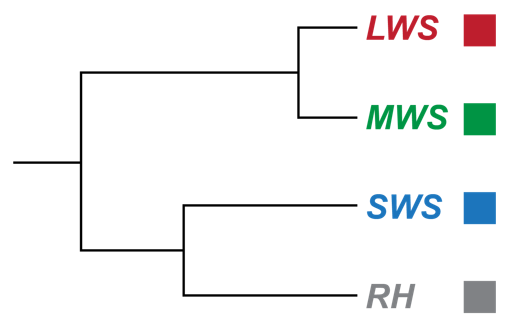Table of contents
- 1. Introduction to Biology2h 40m
- 2. Chemistry3h 40m
- 3. Water1h 26m
- 4. Biomolecules2h 23m
- 5. Cell Components2h 26m
- 6. The Membrane2h 31m
- 7. Energy and Metabolism2h 0m
- 8. Respiration2h 40m
- 9. Photosynthesis2h 49m
- 10. Cell Signaling59m
- 11. Cell Division2h 47m
- 12. Meiosis2h 0m
- 13. Mendelian Genetics4h 44m
- Introduction to Mendel's Experiments7m
- Genotype vs. Phenotype17m
- Punnett Squares13m
- Mendel's Experiments26m
- Mendel's Laws18m
- Monohybrid Crosses19m
- Test Crosses14m
- Dihybrid Crosses20m
- Punnett Square Probability26m
- Incomplete Dominance vs. Codominance20m
- Epistasis7m
- Non-Mendelian Genetics12m
- Pedigrees6m
- Autosomal Inheritance21m
- Sex-Linked Inheritance43m
- X-Inactivation9m
- 14. DNA Synthesis2h 27m
- 15. Gene Expression3h 20m
- 16. Regulation of Expression3h 31m
- Introduction to Regulation of Gene Expression13m
- Prokaryotic Gene Regulation via Operons27m
- The Lac Operon21m
- Glucose's Impact on Lac Operon25m
- The Trp Operon20m
- Review of the Lac Operon & Trp Operon11m
- Introduction to Eukaryotic Gene Regulation9m
- Eukaryotic Chromatin Modifications16m
- Eukaryotic Transcriptional Control22m
- Eukaryotic Post-Transcriptional Regulation28m
- Eukaryotic Post-Translational Regulation13m
- 17. Viruses37m
- 18. Biotechnology2h 58m
- 19. Genomics17m
- 20. Development1h 5m
- 21. Evolution3h 1m
- 22. Evolution of Populations3h 52m
- 23. Speciation1h 37m
- 24. History of Life on Earth2h 6m
- 25. Phylogeny2h 31m
- 26. Prokaryotes4h 59m
- 27. Protists1h 12m
- 28. Plants1h 22m
- 29. Fungi36m
- 30. Overview of Animals34m
- 31. Invertebrates1h 2m
- 32. Vertebrates50m
- 33. Plant Anatomy1h 3m
- 34. Vascular Plant Transport2m
- 35. Soil37m
- 36. Plant Reproduction47m
- 37. Plant Sensation and Response1h 9m
- 38. Animal Form and Function1h 19m
- 39. Digestive System10m
- 40. Circulatory System1h 57m
- 41. Immune System1h 12m
- 42. Osmoregulation and Excretion50m
- 43. Endocrine System4m
- 44. Animal Reproduction2m
- 45. Nervous System55m
- 46. Sensory Systems46m
- 47. Muscle Systems23m
- 48. Ecology3h 11m
- Introduction to Ecology20m
- Biogeography14m
- Earth's Climate Patterns50m
- Introduction to Terrestrial Biomes10m
- Terrestrial Biomes: Near Equator13m
- Terrestrial Biomes: Temperate Regions10m
- Terrestrial Biomes: Northern Regions15m
- Introduction to Aquatic Biomes27m
- Freshwater Aquatic Biomes14m
- Marine Aquatic Biomes13m
- 49. Animal Behavior28m
- 50. Population Ecology3h 41m
- Introduction to Population Ecology28m
- Population Sampling Methods23m
- Life History12m
- Population Demography17m
- Factors Limiting Population Growth14m
- Introduction to Population Growth Models22m
- Linear Population Growth6m
- Exponential Population Growth29m
- Logistic Population Growth32m
- r/K Selection10m
- The Human Population22m
- 51. Community Ecology2h 46m
- Introduction to Community Ecology2m
- Introduction to Community Interactions9m
- Community Interactions: Competition (-/-)38m
- Community Interactions: Exploitation (+/-)23m
- Community Interactions: Mutualism (+/+) & Commensalism (+/0)9m
- Community Structure35m
- Community Dynamics26m
- Geographic Impact on Communities21m
- 52. Ecosystems2h 36m
- 53. Conservation Biology24m
22. Evolution of Populations
Genetic Variation
Struggling with General Biology?
Join thousands of students who trust us to help them ace their exams!Watch the first videoMultiple Choice
Gene trees are evolutionary trees that show the evolutionary lineages of specific genes separate from organisms. Below is a gene tree for the genes that code for opsins in humans. Opsins are the light sensitive proteins in the eyes. Humans have four opsins that are active in visual perception: long-wavelength sensitive (LWS or red-sensitive), medium-wavelength sensitive (MWS or green sensitive), short-wavelength sensitive (SWS or blue sensitive), and rhodopsin (RH, not color sensitive). Which mutational process would be most likely to create a gene tree like this?

A
Point mutations.
B
Deletion events.
C
Horizontal gene transfer.
D
Gene duplication events.
 Verified step by step guidance
Verified step by step guidance1
Begin by understanding the concept of a gene tree. A gene tree represents the evolutionary relationships between different genes, showing how they have diverged from common ancestral genes over time.
Examine the gene tree provided. It shows the evolutionary relationships between four opsins in humans: LWS (red-sensitive), MWS (green-sensitive), SWS (blue-sensitive), and RH (not color-sensitive). Notice how these genes are branched, indicating divergence from a common ancestor.
Consider the mutational processes listed: point mutations, deletion events, horizontal gene transfer, and gene duplication events. Point mutations and deletion events typically alter existing genes but do not create new gene copies. Horizontal gene transfer involves the transfer of genes between organisms, not within a single organism's lineage.
Focus on gene duplication events. Gene duplication is a process where a gene is copied in the genome, resulting in multiple copies of the same gene. These copies can then evolve independently, leading to the diversification of gene functions, as seen in the opsins.
Conclude that gene duplication events are the most likely process to create a gene tree like the one shown. This process allows for the creation of multiple opsins from a single ancestral gene, each evolving to detect different wavelengths of light.

 2:16m
2:16mWatch next
Master Sources of Genetic Variation with a bite sized video explanation from Bruce Bryan
Start learningRelated Videos
Related Practice





























